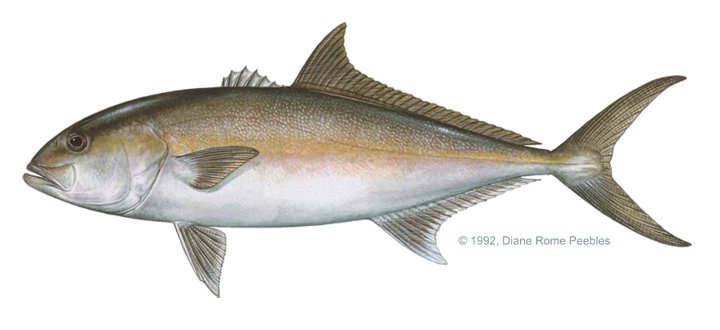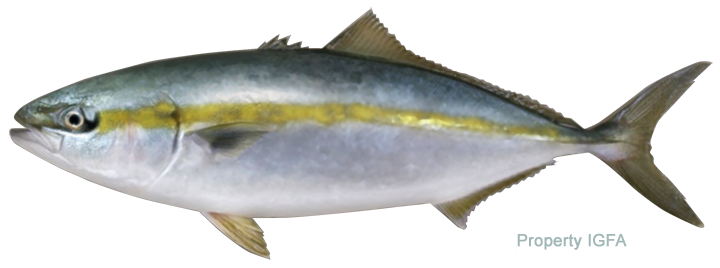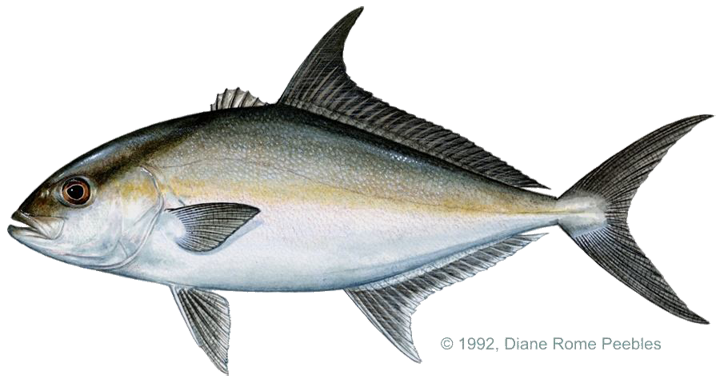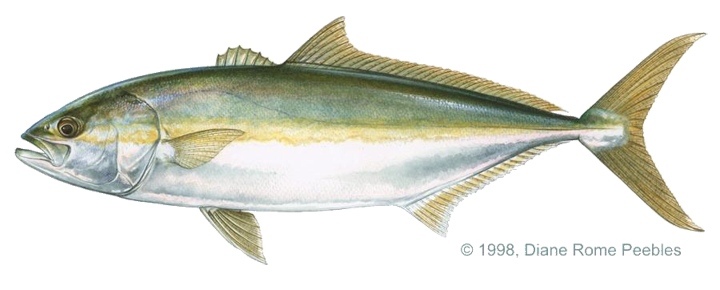Game Fish Identification Reference Guides
Amberjack, greater
(Seriola dumerili)
(Seriola dumerili)

(Risso, 1810); CARANGIDAE FAMILY Found in the Indo Pacific around Japan, China, and the Philippines, in the central Pacific off Hawaii, throughout the western Atlantic Ocean, in portions of the eastern Atlantic Ocean (Madeira and southern and western Africa), and in the Mediterranean Sea in tropical and warm temperate waters. It is found mainly near the surface in open waters, but can be found at considerable depths and around off shore reefs, wrecks, buoys, etc.
The greater amberjack often have a distinctive olive colored bar from the snout through the eye, to the beginning of the dorsal fin and a broad amber colored stripe running horizontally along the flanks. The amber stripe often causes anglers to confuse this species with the yellowtails. However, the greater amberjack can be distinguished from other related species by the gill raker count; greater amberjack over 8 inches long have only 11 16 developed gill rakers on the lower limb of the first branchial arch (the count may be higher in smaller specimens), whereas yellowtails have 21 28.
The rainbow runner has small separate finlets behind the dorsal and anal fins which are lacking in amberjacks. Greater and lesser amberjacks can be separated by counting the total gill rakers; 23-26 are found in lesser amberjacks and 11-19 in the greater.
The greater amberjack is the largest of the jacks and the most sought after by sport fishermen because of its qualities as a game fish. It strikes fast, fights hard and often dives for the bottom. Frequently when one amberjack is brought to the boat, others will follow it to the surface. Fishing methods include trolling near the surface with lures, spoons, plugs, jigs or strip baits, and also live bait fishing. Many incidental catches of amberjack are made while fishing the bottom for snappers and groupers.
The amberjack is high on the list of 300 or more species of tropical marine fishes suspected of causing ciguatera poisoning.
The greater amberjack often have a distinctive olive colored bar from the snout through the eye, to the beginning of the dorsal fin and a broad amber colored stripe running horizontally along the flanks. The amber stripe often causes anglers to confuse this species with the yellowtails. However, the greater amberjack can be distinguished from other related species by the gill raker count; greater amberjack over 8 inches long have only 11 16 developed gill rakers on the lower limb of the first branchial arch (the count may be higher in smaller specimens), whereas yellowtails have 21 28.
The rainbow runner has small separate finlets behind the dorsal and anal fins which are lacking in amberjacks. Greater and lesser amberjacks can be separated by counting the total gill rakers; 23-26 are found in lesser amberjacks and 11-19 in the greater.
The greater amberjack is the largest of the jacks and the most sought after by sport fishermen because of its qualities as a game fish. It strikes fast, fights hard and often dives for the bottom. Frequently when one amberjack is brought to the boat, others will follow it to the surface. Fishing methods include trolling near the surface with lures, spoons, plugs, jigs or strip baits, and also live bait fishing. Many incidental catches of amberjack are made while fishing the bottom for snappers and groupers.
The amberjack is high on the list of 300 or more species of tropical marine fishes suspected of causing ciguatera poisoning.
















